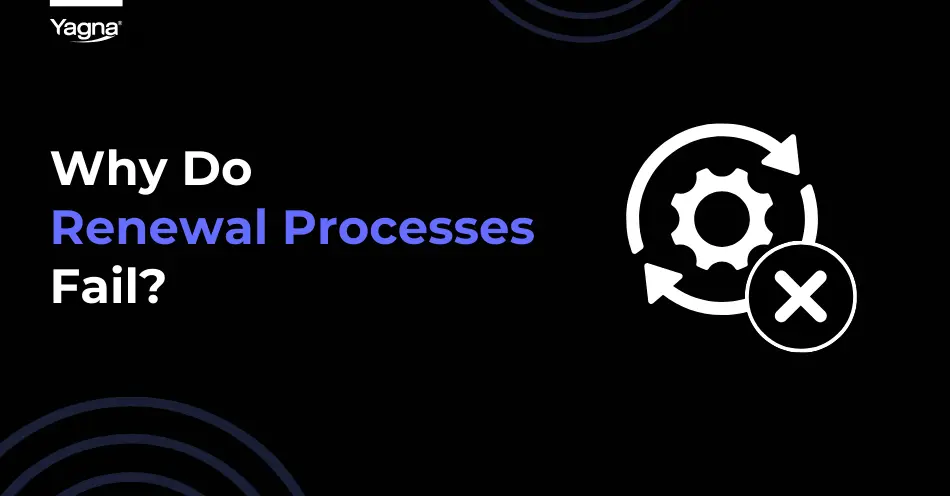
Why Do Renewal Processes Fail?
Whether you’re managing SaaS subscriptions, hardware maintenance contracts, or service agreements, renewals ensure consistent cash flow and long-term customer loyalty. Yet, many companies struggle to achieve smooth renewal processes.
Why?
The reality is renewal processes often fail due to avoidable pitfalls. let’s explore the most common reasons behind renewal failures and actionable solutions to fix them.
1. Poor Visibility into Expiring Contracts
One of the most frequent reasons renewal processes fail is the lack of visibility into expiring contracts. Renewal managers often have to sift through multiple spreadsheets and disconnected systems to identify upcoming renewals. This approach is time-consuming and prone to errors.
Signs of Poor Visibility:
- Missed renewal deadlines
- Last-minute scrambling to contact customers
- Increased customer churn
Invest in a renewal automation platform that provides a centralized dashboard with proactive alerts. Automated reminders 90, 60, and 30 days before contract expiry can help renewal managers stay ahead of deadlines, ensuring no opportunity is overlooked.
2. Manual Processes and Human Errors
Businesses are still relying on manual processes for managing renewals. Whether it’s using spreadsheets or manually creating quotes, these outdated methods increase the likelihood of mistakes.
Common Manual Process Errors:
- Incorrect pricing on renewal quotes
- Sending quotes to the wrong customer
- Forgetting to follow up on pending renewals
Digitize your renewal workflows. A Digital renewal platform can handle data entry, generate quotes and send reminders automatically. This reduces human error, speeds up the process, and frees up your team to focus on more strategic tasks.
3. Poor Communication with Customers/ Partners
Effective communication is crucial for successful renewals. Yet, many renewal managers only reach out to customers when a contract is about to expire. This last-minute approach creates unnecessary stress for both parties.
Impact of Poor Communication:
- Partners feel rushed to make decisions
- Reduced renewal rates due to lack of engagement
- Frustrated partners who feel undervalued
Start renewal conversations early. Use email sequences to engage partners well before their contracts expire. Personalize your outreach to make partners feel valued and informed about their options.
To know more read the blog about how to design your successful renewal email.
4. Ignoring Smaller or Long-Tail Partner Accounts
Many companies focus their renewal efforts on high-value accounts, neglecting smaller or long-tail partners. While these accounts may generate lower individual revenue, collectively, they can make a significant impact on your bottom line.
Consequences of Ignoring Long-Tail Accounts:
- Missed incremental revenue opportunities
- Reduced customer loyalty
- Higher churn rates among smaller accounts
Implement a scalable, self-service renewal portal. This allows smaller partners to renew contracts easily without requiring extensive support. By automating the renewal process for long-tail partner accounts, you can unlock hidden revenue potential.
5. Outdated Pricing and Margin Calculation
Renewal managers often face challenges with pricing and margin calculations. Using outdated price lists or manual calculations can slow down the renewal process and create friction for partners.
Common Pricing Challenges:
- Inconsistent pricing across quotes
- Difficulty calculating margins accurately
- Delays in sending renewal quotes
Adopt a CPQ (Configure, Price, Quote) tool that dynamically updates pricing based on real-time data. A CPQ solution ensures accurate, consistent quotes while simplifying margin calculations, speeding up the entire renewal process.
6. Lack of Data-Driven Insights
Renewal managers often lack the insights needed to improve their processes. Without data, it’s challenging to identify what’s working and where improvements are needed.
Impact of Missing Insights:
- Difficulty predicting renewal success rates
- Inability to identify at-risk partners
- Missed opportunities for upselling or cross-selling
Use an analytics dashboard to track renewal performance. Look for metrics such as renewal rates, partner engagement, and revenue growth. These insights can help you fine-tune your renewal strategies and make data-driven decisions.
7. Not Addressing Customer Concerns
Customers often have concerns about the renewal process that go unaddressed. Whether it’s pricing issues, contract terms, or product changes, failing to address these concerns can lead to churn.
Common Customer Concerns:
- “Why is the price higher than last year?”
- “Can we adjust the contract terms?”
- “What new features are included?”
Ensure renewal managers are prepared to handle partner objections. Provide them with the necessary resources to address common concerns and negotiate effectively. Offering flexibility and clear communication can go a long way in retaining partners.
Conclusion: Turning Pitfalls into Opportunities
Renewal processes fail when they are reactive rather than proactive. By addressing these common pitfalls — from improving visibility to automating workflows and enhancing communication — you can create a smoother, more successful renewal process.
The key is to stay ahead of the curve. Don’t wait until a contract is about to expire. Start early, leverage automation, and keep communication channels open. Your partner/customer will appreciate the proactive approach, and your business will benefit from increased renewal rates and stronger relationships.
Ready to take your renewal process to the next level? Let’s talk about how digitization can help you achieve just that.